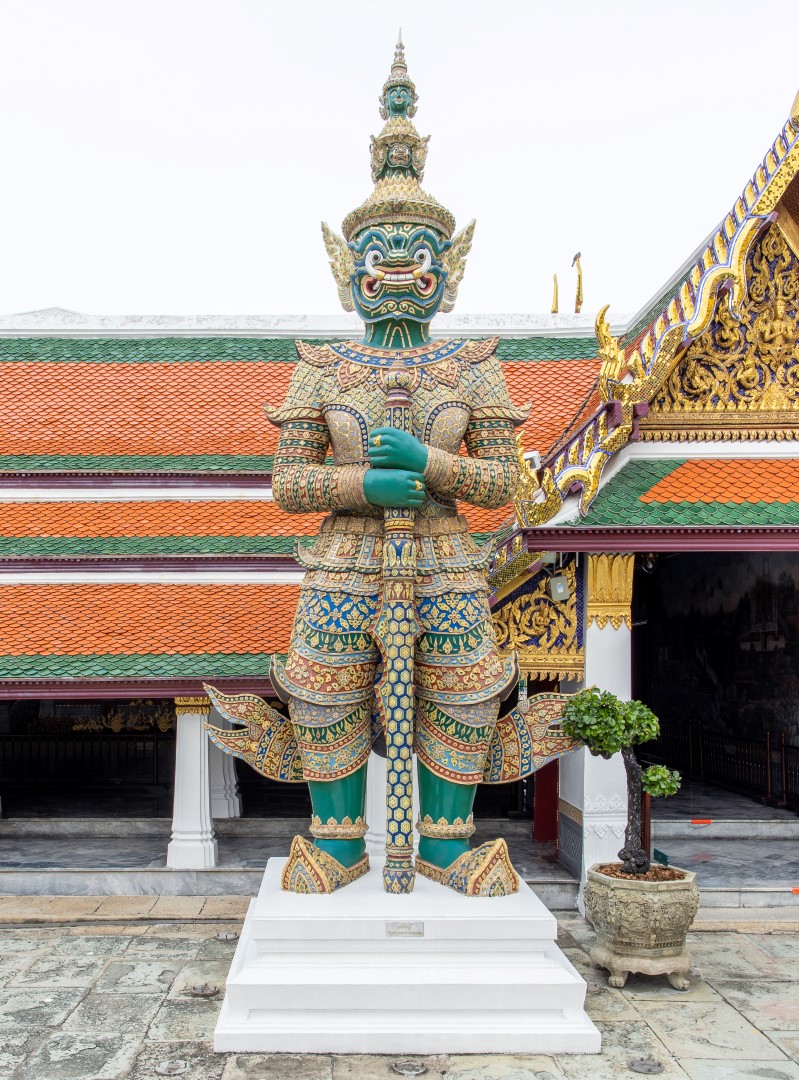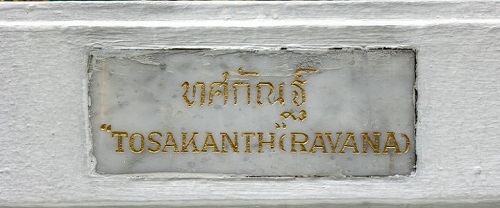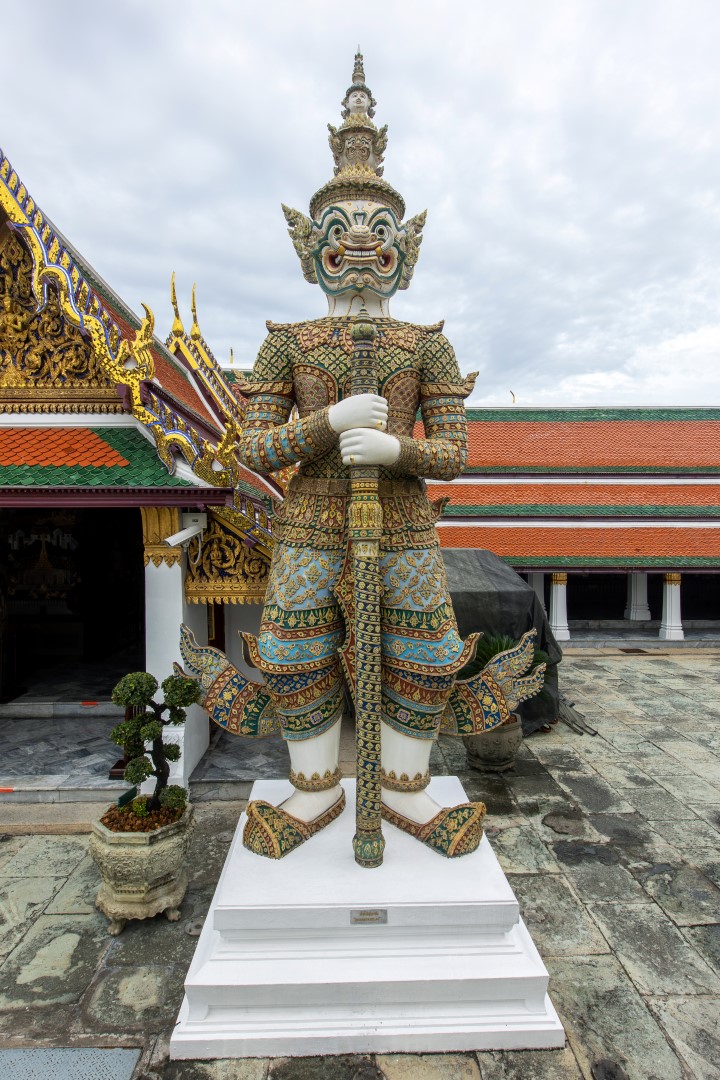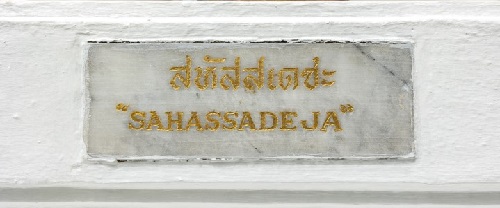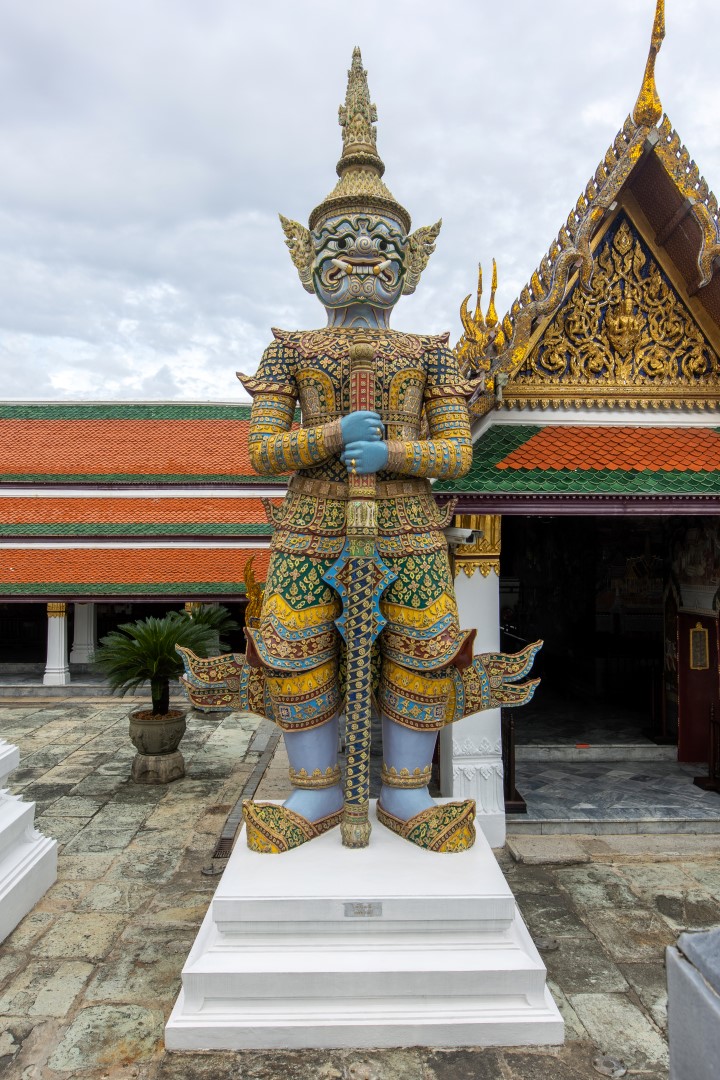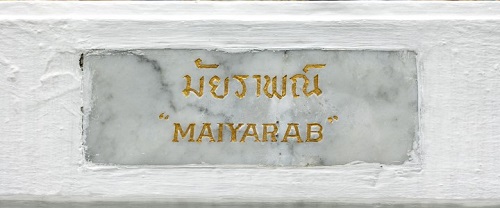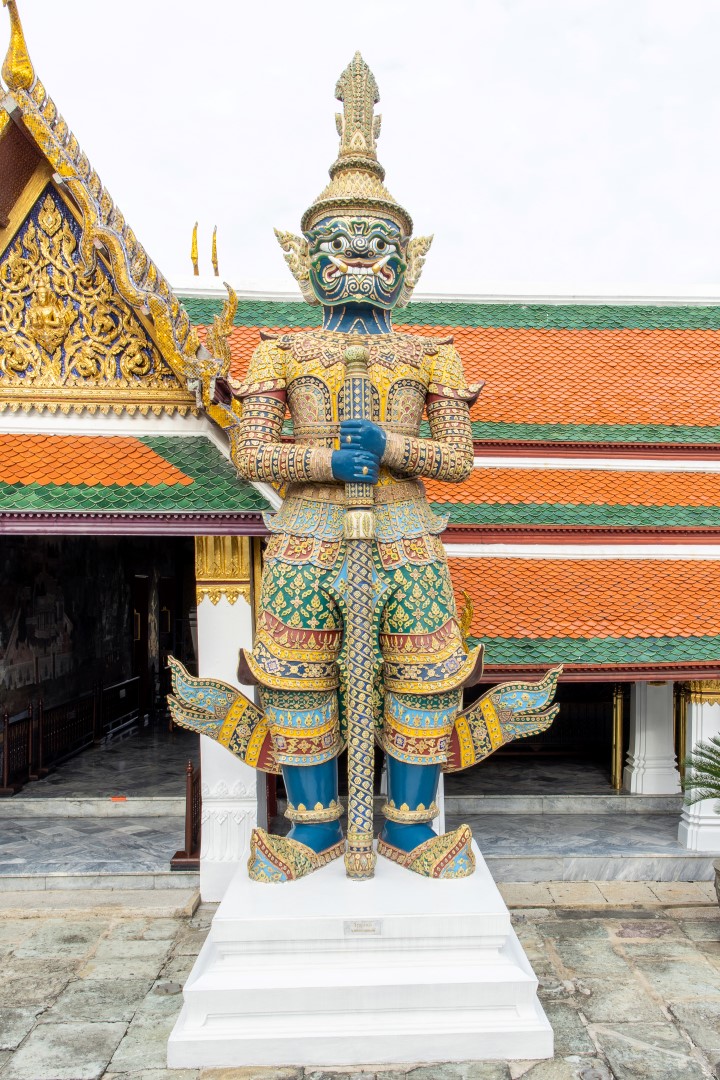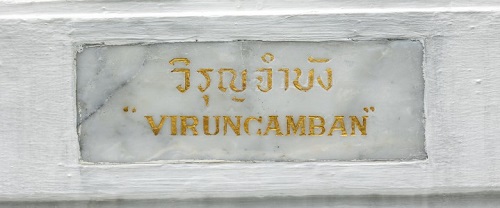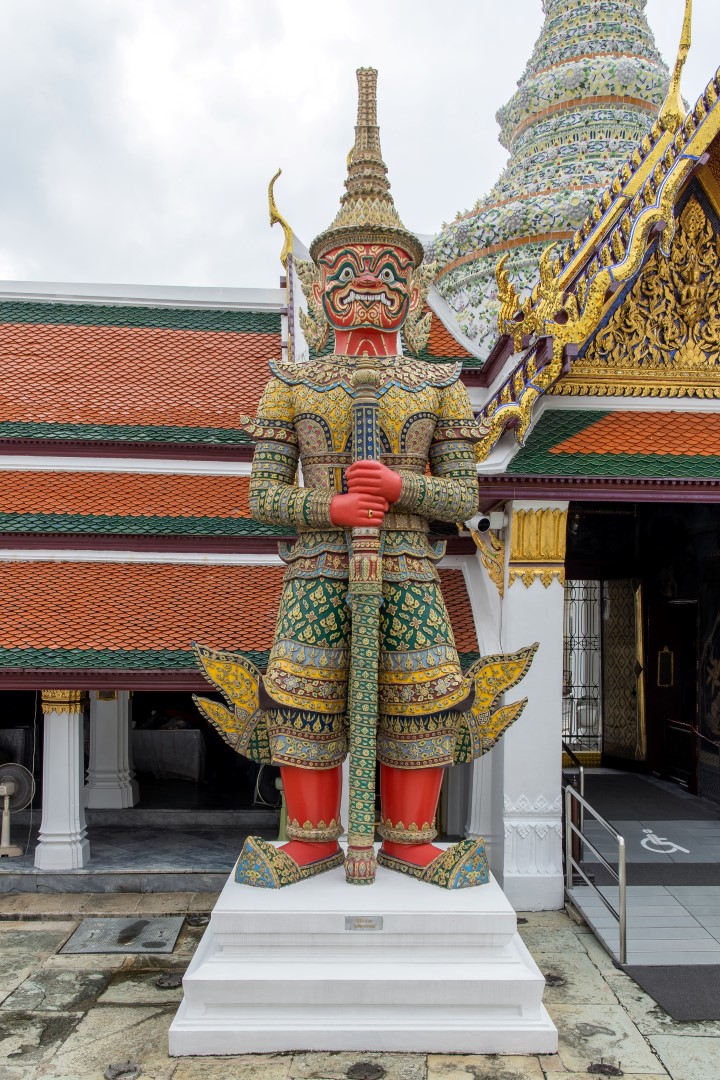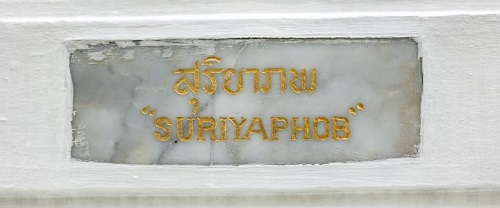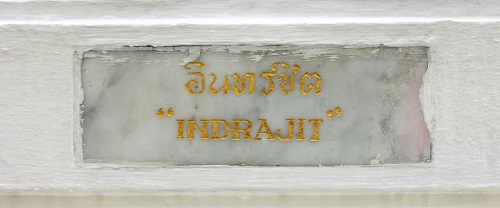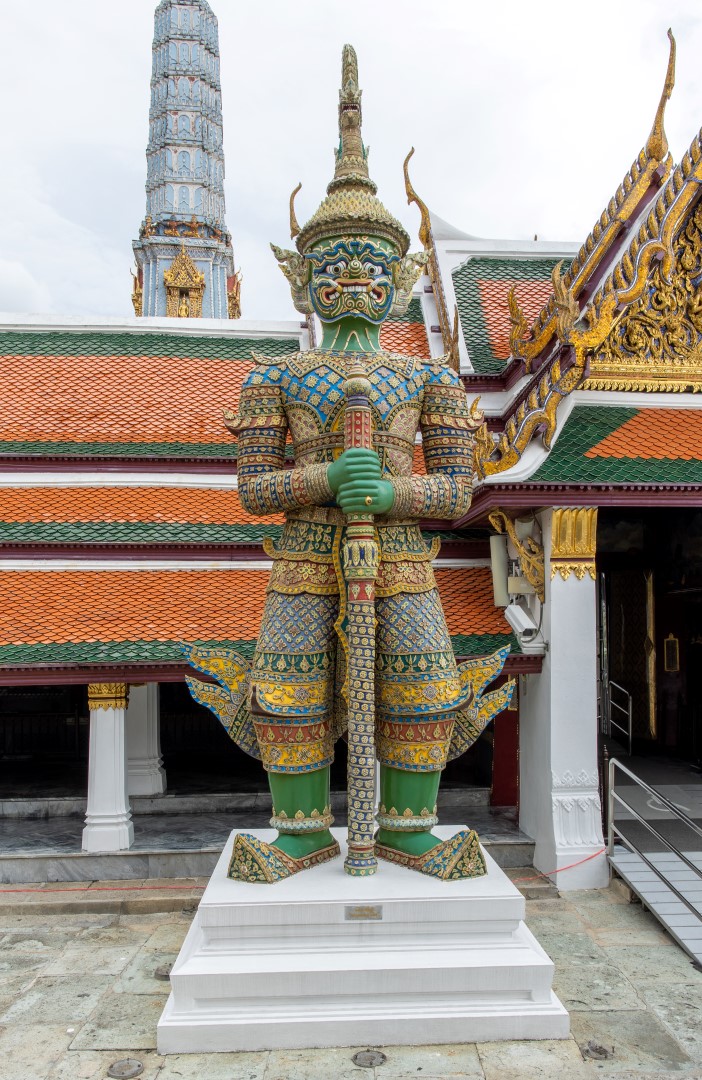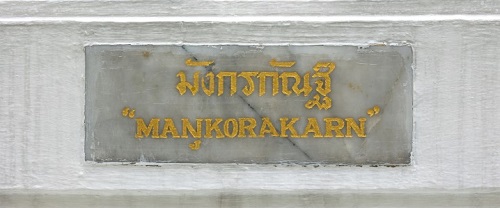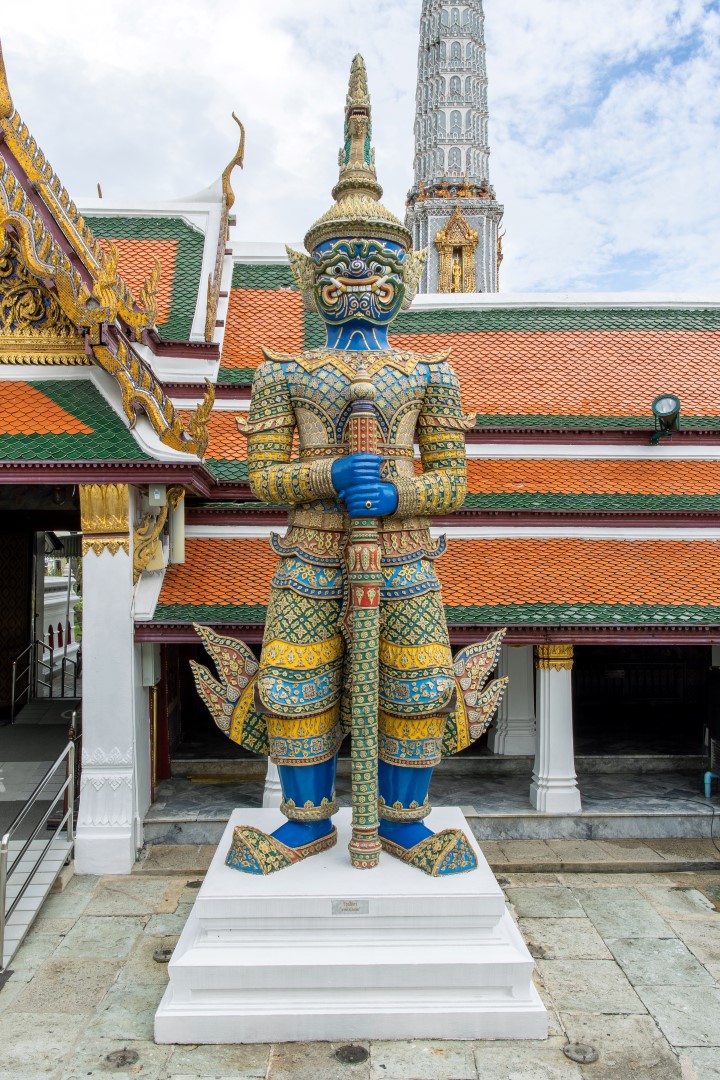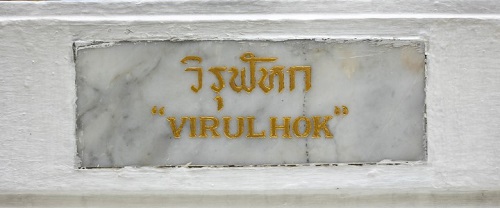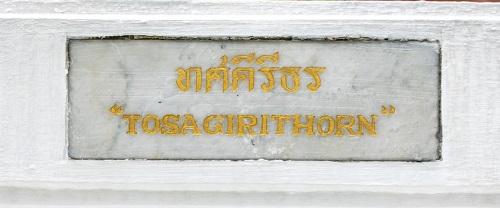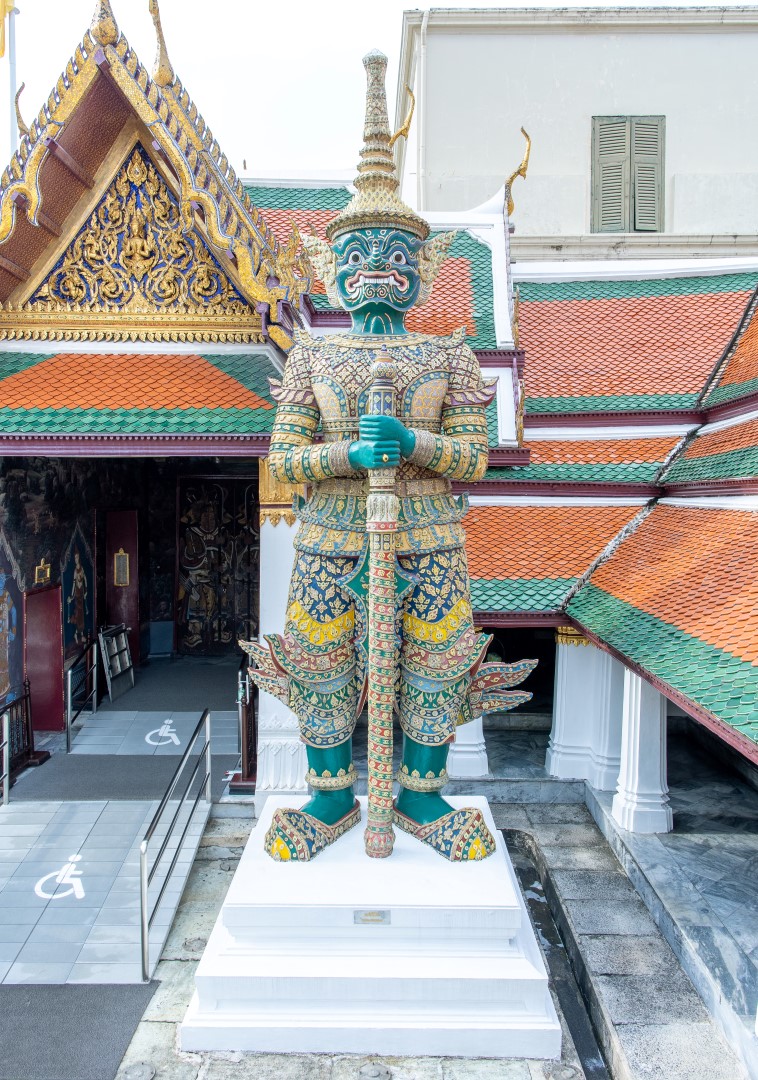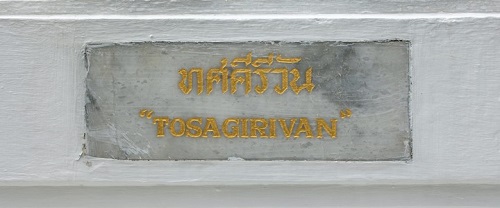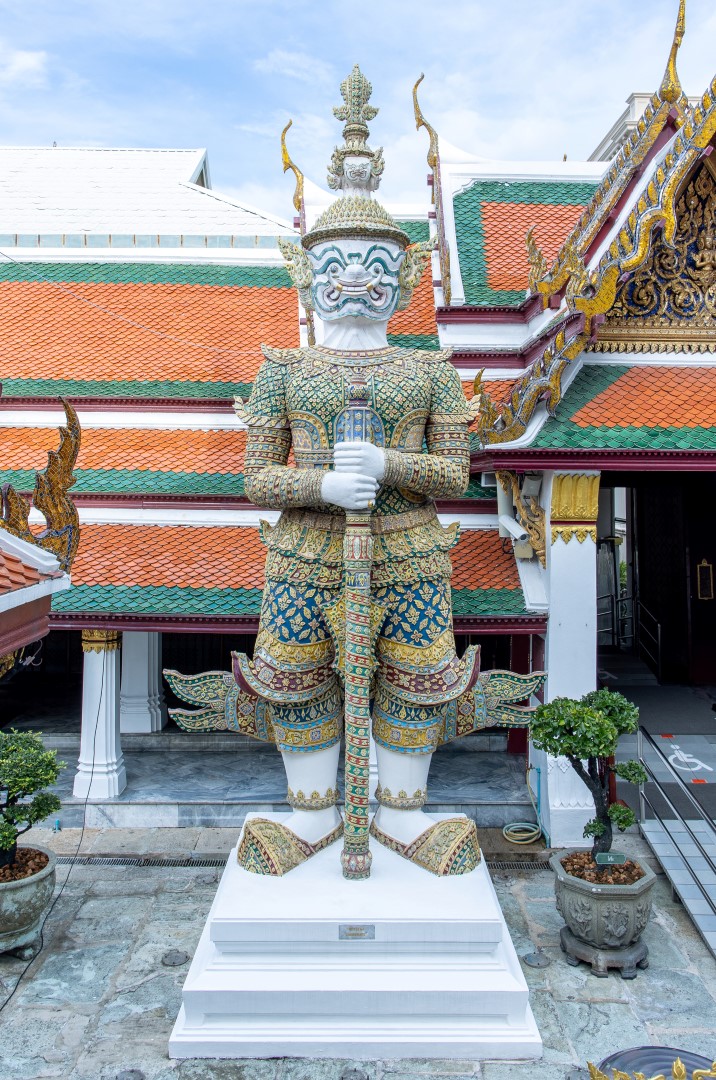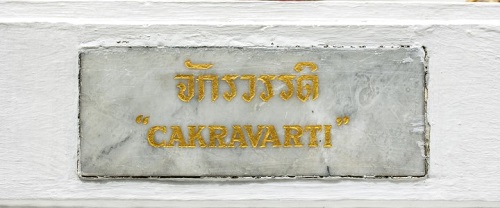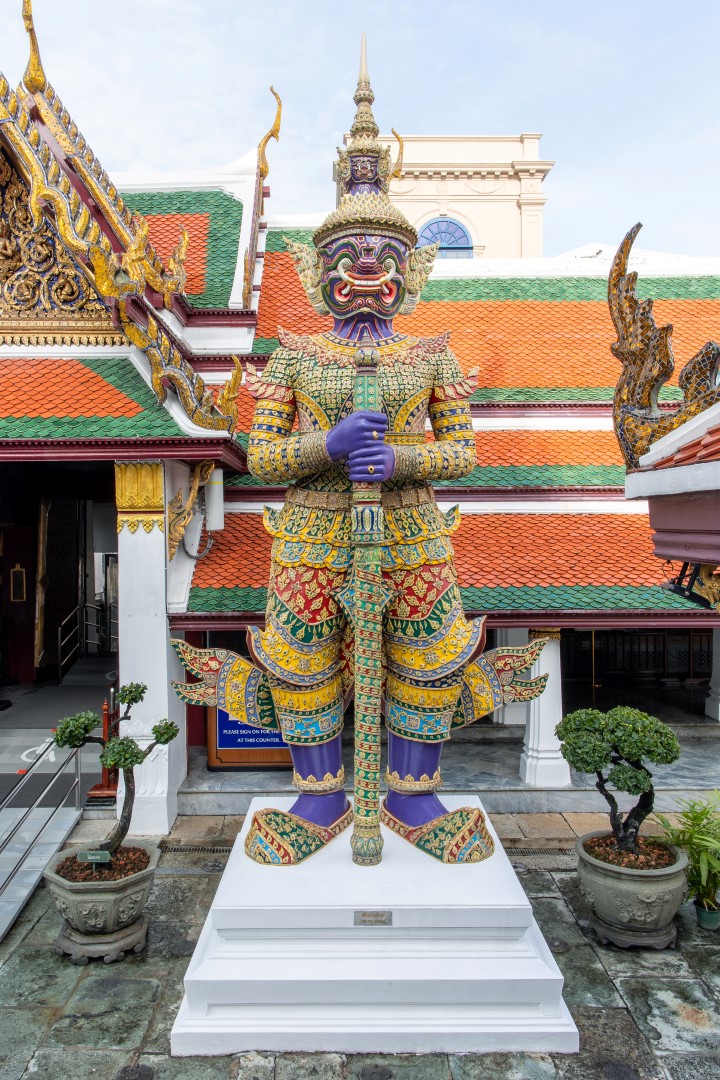The area of the Buddha’s entrance, the inner balcony of the Temple of the Emerald Buddha Since the Giant Gate masonry Painted and decorated with glazed tiles with a height of 6 meters, a total of 6 pairs, built in the reign of King Nang Klao Chao Yu Hua. These giant gatekeepers are important characters in the Ramayana literature.
Thotsakan or Tosakanth (Ravana) Demon royalty
Thotsakan or Tosakanth (Ravana) is in green, has three tiers. The first tier has a single face and three small faces at the nape of his neck. The second tier has four small faces facing in four directions. The third tier has the face of Brahma in the front and a demon face at the back of the head. He has a grimacing mouth, wide- open eyes and wears the mongkut yod chai or victory crown.
Altogether Thotsakan has ten faces and twenty arms. He is the first son of Thao Lastian and Rachada and the third king of Lanka. Mondo and Kala-akki are his queens. Other than that, he has a host of minor wives and 1,015 children and two daughters. He is very crafty, but yet evil and vulgar. He seems invincible and can even remove his hearts from his own body without assistance. Thotsakan abducted Nang Sita from the forest hermitage and can be blamed for instigating the ensuing mighty battle between Phra Rama and Thotsakan that followed. He was also responsible for the deaths of his own demon relatives. In the end Phra Rama killed him with his bow and arrows with the help of his very able monkey commander, Hanuman, who stole the box containing his hearts.
Sahasadecha or Sahassadeja Raksot demon king
Sahasadecha or Sahassadeja has four or five tiers. The first tier has an ordinary face at the front and three small faces at the back of his head hard upon the hairline. The topmost tier comes in two styles with either demon or Brahma faces. He has a grimacing mouth with wide-open eyes and wears the mongkut chai (a victory crown).
With a white complexion, the classical image of Sahasadecha displays a thousand faces and two thousand arms. He rules over the city-state of Pangtarn and is the older brother of Moonplum. He has a magical cudgel-when the top of the cudgel is pointed at any living creature it dies but when the bottom of the cudgel is pointed, dead creatures are restored to life. Having received blessings from the God Brahma, he was vouchsafed special powers, including the power of being able to scatter opposing soldiers in all directions as a military stratagem.
When Thotsakan asked his younger brother, Moonplum, to provide military assistance to Lanka, Sahasadecha also joined in the battle. After Moonplum was slain, Sahasadecha sought to wreak vengeance and Hanuman killed him by breaking the magical cudgel, thence ensnaring him with his tail, he thereupon beheaded the demon.
Maiyararp or Maiyarab Demon royalty
The face, body and two arms of Maiyararp or Maiyarab are the colour of light purple. He has a clinched mouth and crocodile eyes. He either wears the mongkut kranok (a kranok emblem- topped headdress).
He is the son of Mahayomayak and Jantraprapa and the younger brother of Pirakuan. He ruled over Badarn after the death of Thao Mahayomayak. He had the ability to cast spells. Upon assenting to Thotsakan’s request to assist him in battling Phra Rama’s troops, Maiyararp cast spells on Phra Rama’s soldiers. Phra Rama was accordingly captured and brought to Badarn. However, Hanuman followed, killed Maiyararp and rescued Phra Rama.
Wiroonjumbang or Virungamban Demon royalty
The face, body and arms of Wiroonjumbang or Virungamban are the colour of mor meuk. With a clinched mouth and crocodile eyes, he wears the mongkut haang kai (a headdress topped by a cock’s tail emblem). He is the son of Phya Thoot and became the ruler of Jareuk after his father died. Wiroonjumbang has a horse named Nilapahu with both having the ability to become invisible.
Wiroonjumbang took his army to assist Thotsakan and joined the army of Thao Sattasoon. Phra Rama killed his horse with his arrow and so he fled to hide in a water bubble in the vicinity of Mount Askan where Hanuman sought him out.
Suriyapop or Suriyaphob Demon
Suriyapop or Suriyaphob’s face, body and two arms are the colour of daeng chaat. He has a clinched mouth and wide-open eyes. The base of his face is similar to Inthorachit’s. He wears the chada yod dern hon (a headdress for travelling) in the same style as that of Inthorachit. He wears human earpieces.
Suriyapop is the first son of Thao Jakrawat and Watchaneesoon. He is able to use the magical Mekhapat spear. When Phra Prot attacked Maliwan with his army, Suriyapop hurled his spear at Phra Satrut until the latter was struck and thence collapsed. The next day Phra Prot killed Suriyapop with an arrow.
Inthorachit or Indrajit Demon royalty
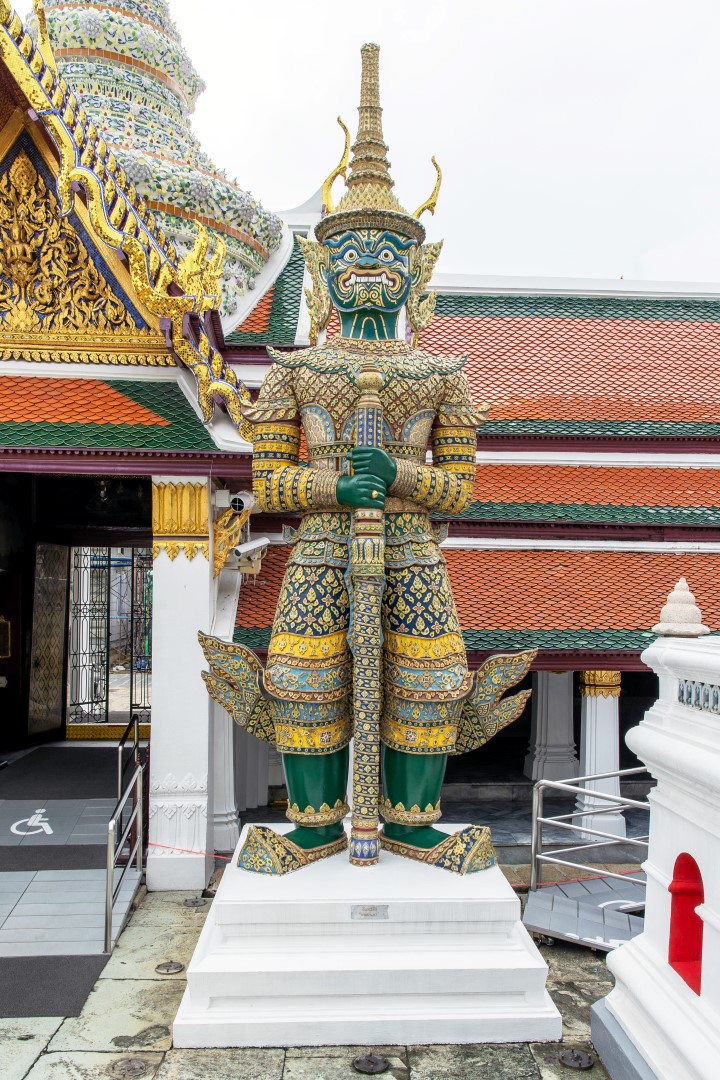
Inthorachit or Indrajit’s face, body and two arms are green, he has wide-open eyes and a clinched mouth with kheaw dok mali or fangs that curl downwards. He either wears a chada yod dern hon (headdress for travelling) in the same style as that worn by the god Indra. He has two kinds of earpieces with one kind being similar to what humans wear. He is the son of Thotsakan and Mondo. Suwankanyuma is his consort and Yamaliwan and Kanyuwek are their sons.
Inthorachit or Indrajit’s original name was Ronapak. After he had fought a victorious battle against the god Indra, Thotsakan changed his name to Inthorachit with the Sanskrit original of his name-“Indrajit”–literally meaning the “conqueror of Indra” (the king of the gods). At the time of his birth, he received blessings from three deities, viz., Phra Isuan,, Phra Brahma and Phra Narai. In the case of Phra Isuan, he was assured that he would never die on the face of the earth, but only in the air. However, if decapitated, were his head to fall to the earth, universal destruction by cataclysmic, apocalyptic fire would ensue in accordance with the dictates of the blessing.
After Inthorachit fought many battles against Phra Rama as recounted in all extant versions of the story, in a version found only in the Thai Ramakien, Inthorachit was finally killed by Phra Rama’s arrow by being decapitated in the sky above the knoll known as the “Universal Knoll” (เนินจักรวาล Nern Jakgrawarn) in view of the projected universal destruction had his severed head hit the ground.
This apocalyptic scenario was averted when Ongkot (Angada) brought a diamond bowl from heaven provided by Thada Brahma so as to catch Inthorachit’s head in the air before it could fall to the earth, thereby averting the conflagration that would have otherwise utterly destroyed the earth.
Mangkornkan or Mankorakarn Demon royalty
Mangkornkan or Mankorakarn is green. With clinched mouth and crocodile eyes. Mangkornkan or Mankorakarn wears a mongkut yod naga (a serpent-topped headdress). He has a green face, green body and two arms. He is the son of Phya Khorn and Rachada and the reincarnation of a rebellious water buffalo Phya Torapee who failed to show paternal fealty. After Phya Khorn died, he ruled over the principality of Romekan. It was at a time of war that Thotsakan sent Mangkornkan out with a regiment of his own to fight against Phra Rama’s army. In the ensuing battle, he was killed by Phra Rama’s arrow.
Wiroonnahok or Virulhok Male deity
The face, body and two arms of Wiroonnahok or Virulhok are a shade of mor kraam. He wears the mongkut yod dern hon (a travelling headdress). A ruler of lesser deities and demons, he controls the southern direction.
When Wiroonnahok or Virulhok was earlier a raksot ruler, he had a blue complexion, wore the mongkut yod naga (a serpent peaked headdress) with the serpent being poisonous and lived in Badarn, the land beneath the sea in the vicinity of the valley below Mount Treegood. Some chronicles say that he lived in the city of Maha-anthakarn.
Wiroonnahok paid his respects to Phra Isuan seven times a year by visiting him in his heavenly abode. As seen several times above, on one occasion when the time came for him to visit Phra Isuan, as was his wont, he laboriously climbed the steps up Mount Krailart. With each step, he would make a bow. A gecko that lived at the top of the mountain saw this and mocked him. When Wiroonnahok saw this, he was so angry that he took off his serpentine chain and threw it at the gecko with such force that it caused the mountain to lean as related in the following verse:
Tosakirithorn or Tosagirithorn Demon
The face, body and two arms of Tosakirithorn or Tosagirithorn are the colour of hong din. He has a clinched mouth and crocodile eyes. He has an elephant trunk for a nose and wears the mongkut kap phai yod dok lamphong (a bamboo bract topped by a trumpet-flower shaped headdress).
He rides a parn dam horse (a piebald black horse), He is the son of Thotsakan and the elephant maiden. He went to visit Thotsakan at the same time as Tosakiriwan, his brother. Both fought on behalf of Lanka. The arrow of Phra Lak killed both brothers.
Tosakiriwan or Tosagirivan Demon
Tosakiriwan or Tosagirivan’s face, body and arms are green. He has a clinched mouth and crocodile eyes. He has an elephant’s trunk for a nose and wears the mongkut kap phai yod dok lamphong (a bamboo bract topped by a trumpet-flower shaped headdress). He has a single face and two arms and rides a parn kao horse (piebald white). He is the son of Thotsakan and the elephant maiden. Thao Asakan-marasoon, a friend of Thotsakan, adopted him. On one occasion, he came to visit Thotsakan and was asked to join in battle with the forces of Lanka, but was later killed by Phra Lak’s arrow.
Jakrawat or Cakravarti Demon royalty
The four faces, body and eight arms of Jakrawat or Cakravarti are white. He has two tiers of head with the first tier having one ordinary face while the second tier has three small faces. He has a grimacing mouth and wide-open eyes. He wears the mongkut haang kai (a headdress topped by a cock’s tail emblem). Jakrawat is the ruler of Maliwan city-state and is Thotsakan’s friend. Wachaneesoon is his queen. They have three sons: Suriyapop, Banlaijak and Nonyupak, and one daughter named Ratanamalee.
Later, when Painasuriyawong discovered that Thotsakan was his real father, he journeyed to see Jakrawat to ask for an army to regain Lanka. The Maliwan ruler thus went to Lanka and imprisoned Pibhek (Thao Tosakiriwong). Jakrawat placed Painasuriyawong on Lanka’s throne and gave him the name of Thao Tosapin. Phra Prot, Phra Rama’s brother, brought his army to war with Lanka and then went on to Maliwan to fight with Jakrawat who died in the course of combat.
Thao Askan or Askan-mara Demon king
The seven faces, single body and two arms of Thao Askan (Askanmarasoon) or Askan-mara are all dark purple. Thao Askan’s head are placed in two tiers. The first tier has an ordinary face at the front and three small faces are found on the neck at the hairline and the second tier has three small faces. He has a grimacing mouth and wide-open eyes and wears a mongkut chai (a victory headdress).
He rules over the city-state of Duram and adopted Thotsakan’s sons-Tosakiriwan and Toskirithorn. When they both died in battle, he led his army to fight against Phra Rama’s army. Phra Rama shot his arrows, thereby cutting Askanmarasoon into eight parts but he did not die, but hydra-like simply multiplied himself. Later when Pibhek joined Phra Rama’s army, he advised Phra Rama to sweep all of Askanmarasoon’s bodies into the Ganges (Ganga) River as that was the only way to kill him once and for all.

